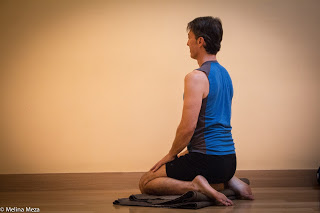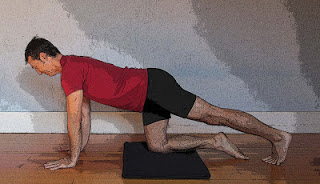by Nina and Baxter
In Baxter’s post Getting Comfortable in Easy Sitting Pose, in which he provided recommendations for making your Easy Sitting Pose more comfortable, he proposed Hero Pose as an alternative pose for those who can’t sit in Easy Sitting Pose for long periods of time. However, in Hero pose, the challenges for your body are different than they are for Easy Sitting Pose (Sukasana). Anatomical variations that affect your ability to get comfortable in this pose include your level of flexibility in your knee joints, ankle joints, lower spine, front thigh muscles, and even the tops of your feet. However, in general, the five recommendations below for propping and practicing the pose will allow you sit in Hero Pose comfortably even if you are stiff in one or more of those areas.
Caution: As with any pose, please come out of this one if you experience pain or anxiety while practicing it. Then try the pose again with different propping. If you simply cannot get comfortable in Hero Pose no matter what you do, practice another pose instead. For long seated sessions, you may find that switching between Hero Pose and Easy Sitting Pose can be helpful. And, of course, sitting on a chair for seated meditation or breath practices is always a good alternative.
1. Pad Your Shins and Support Your Pelvis

Using padding under your shins makes your knees, shins, and feet more comfortable in the pose (no bones pressing right into the floor!).
Having a support under your pelvis is beneficial for those you are less flexible in the knee joints, front thigh muscles, lower spine, and ankle joints. Sitting on a prop allows pelvis to tilt slightly forward so your lower spine can take it’s natural curve, which creates a healthier seated position than if your lower back is rounded.
Baxter, who is somewhat less flexible in the knees and fronts of his thighs, always sits on at least one block on its lowest or
middle or lower height. But everyone is different, so we suspect you will need to experiment to discover the height that is best for you. And in general if you feel pain in the pose, you should try again with a higher prop.
To come into the pose, start
by placing a folded blanket on your mat that’s large enough to support your knees and shins. Then
kneel on the blanket, with your knees near front of blanket, and your
ankles and feet hanging off the back edge. Have your knees hips-distance
apart, but splay your shins a bit wider apart in back.
Then place a block on
its lowest or middle height (or a stack of two blocks) sideways between
your feet, so both sitting bones can rest on it). And if you want to sit very high on a cushy surface, try sitting on the end of a bolster. Then carefully sit
back on the prop. Adjust your pelvis, as you might move it in Cat/Cow
pose, until your lower back feels like it has a nice natural arch.



2. Support Your Ankles
Some practitioners have stiff, inflexible ankles. So if your ankles are uncomfortable even with the props shown above, you can use a
blanket roll under your ankles to relieve that tension. (To improve ankle
flexibility in the long run, practice poses such as Child’s pose/Balasana and Cobra pose/Bhujangasana that stretch your ankles and
the tops of your feet.)


3. Support Your Feet
If
the tops of your feet are tight and the blanket roll doesn’t work for
you (it makes things worse for Nina!), you can sit on a stack of
blankets (2, 3, or even more) and let your feet hang off the back edge.
To
come into the pose, place the prop you’ll be sitting on near the back
edge of the blanket stack. Next kneel on the blanket stack with your
ankles at the very back edge of the blanket on either side of the prop
and your feet hanging off. Then lower yourself onto the prop with your
ankles on the stack but your feet hanging off.

4. Create Your Inner Lift
An important way to keep your body happy in this pose is to stay focused and active as your practice it rather than just sagging in the pose. To do this, as you continue to sit, focus on lengthening the center of your spine up from your sitting bones through the crown of your head.
Notice
how long you can maintain this feeling of inner lift before you begin
to sag and lose support. Then, try to re-establish the movement again
for a while. If you start to tire and can no longer easily maintain your
inner lift, stop for the day and note how long you sat. Try to
gradually spend more time in your seated position, so that eventually
you will be ready to sit for longer periods of time.
5. Come Out Carefully

To protect your knees in this pose, it’s a good idea to come out of the pose carefully—especially if you end up sitting for
longer periods of time—because your knees have been deeply flexed in
this position. So when you’re ready to come out, carefully shift forward onto
your hands and knees and stretch one leg at time back behind you to open up
your knee joints. You may even wish to practice a Standing Forward Bend afterward to open your knee joints even more.
Follow Yoga for Healthy Aging on Facebook ° To order Yoga for Healthy Aging: A Guide to Lifelong Well-Being, go to Amazon, Shambhala, Indie Bound or your local bookstore.


Leave A Comment